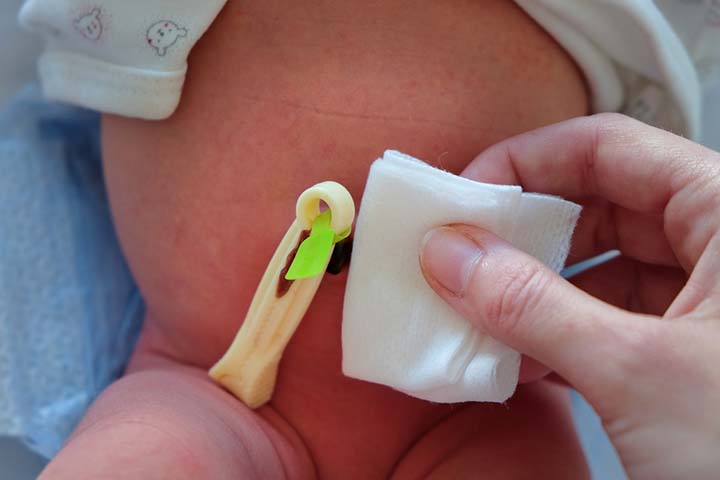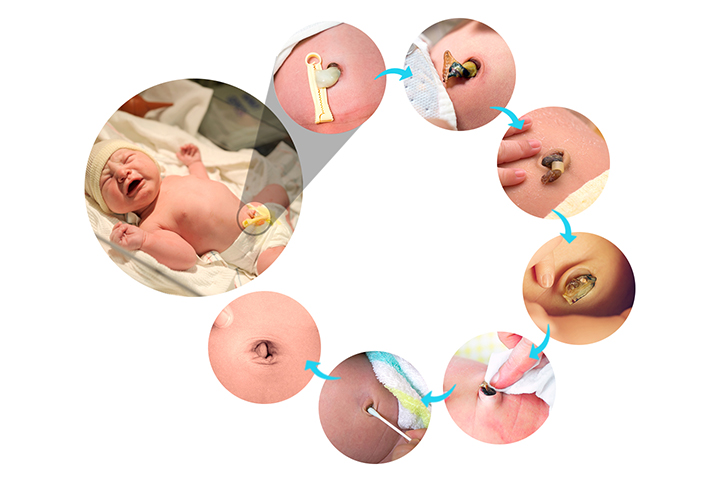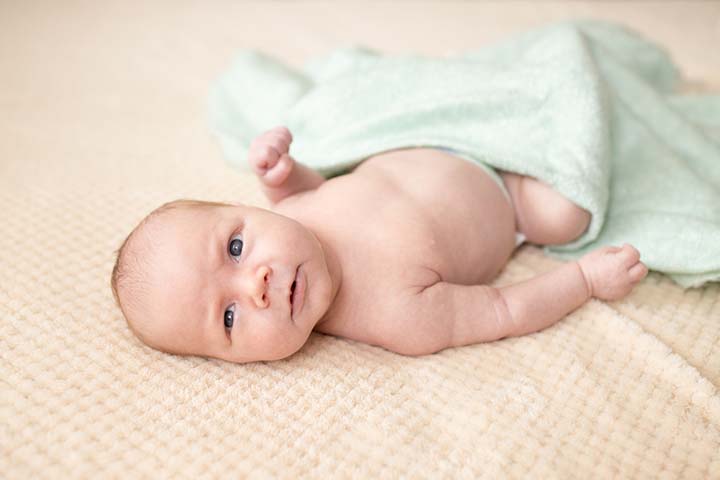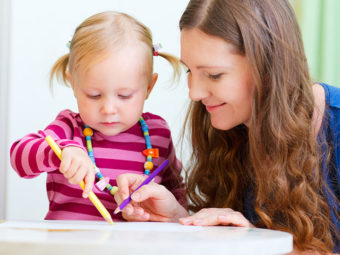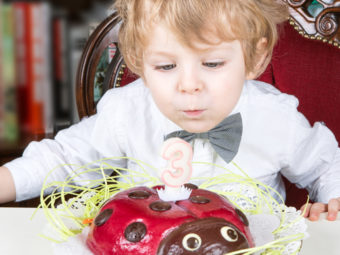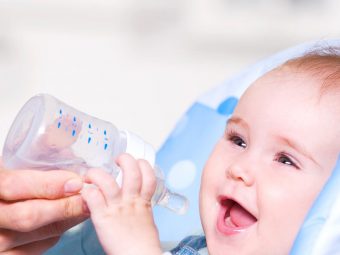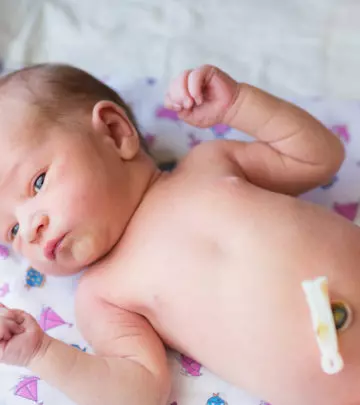
Image: Shutterstock
It’s incredible how a woman’s body gives the fetus a home, allows it to grow, and guarantees that it receives the nutrition it needs to thrive through the baby’s umbilical cord connected to the mother’s placenta.
The umbilical cord is disconnected at birth, leaving a stump behind on the baby’s belly. This stump dries and falls off eventually, and that is when the baby’s belly button or navel (umbilicus) appears. However, until then, you need to take extra care of the umbilical cord stump to avoid any potential infections.
This post explains how to properly care for your baby’s umbilical cord stump, including tips on spotting signs of infection and when to seek medical help.
What Is Umbilical Cord?
The umbilical cord forms during the seventh week of pregnancy. It supplies the developing fetus with oxygen and nutrients, and a means of eliminating waste. Your baby’s umbilical cord is composed of:
- One vein that carries oxygen and nutrient rich blood from you to your growing baby (1).
- Two arteries that transport de-oxygenated blood and fluid matter from your child’s bloodstream to the placenta.
These three blood vessels are encapsulated in a sticky substance known as Wharton’s jelly, which, in turn, is covered by a membrane called amnion.
As the time for the baby’s birth nears, the umbilical cord carries antibodies from you to your baby, to help the baby ward off infections for the first few months after birth. You pass on the antibodies that are present in your bloodstream.
After the baby’s birth, the cord becomes unnecessary as the baby can feed, breathe and empty the bowel and bladder without its help. Therefore, it is clamped and cut after delivery.
A small clamp is put a few centimeters away from the umbilicus, and the cord is cut off. The remaining stump will be around two to three centimeters.
 Did you know?
Did you know?Tips To Take Care Of Umbilical Cord
The clamped umbilical stump is unsightly, and you might not want to keenly look at it or touch it. But you need to take care that it is healing normally. It is important to keep your baby’s umbilical cord stump and the skin around it clean and dry. This will make the stump shrivel and fall off, and also prevent infection (2).
- Keep it clean: If the stump is sticky or dirty, dab it gently with a wet cloth or clean with plain water. Then dry it with a clean cotton cloth to remove any moisture around it. Do not use any soap or alcohol unless instructed by the healthcare providers, as it can irritate the skin. Some areas or countries still use surgical spirits to clean the stump. This is dependant on various factors, such as the rate of stump infections. Your healthcare provider will assist you with the best choice for you and your baby.
Image: Shutterstock
- Keep it dry: Expose the stump to air so that the base dries out quickly. See to it the diaper does not fall over the stump. On warmer days, dress the baby in such a way that the cord area gets enough air.
- Go for sponge bath: Do not dunk the stump under water until it falls off. Sponge baths are ideal at this time. Once the stump shrivels, you may bathe your neonate in a baby sink or tub.
- Change diapers carefully: Some diapers have a little notch in the waist area. You may fold down the diaper at the belly button area so that it will not fall over the stump. Also, change the dirty and wet diapers carefully so that they do not leak around the navel area.
 Quick tip
Quick tip- Choose loose-fitting dresses:Buy tops or onesies that have a special cut near the stump. Use kimono-style clothing as they allow proper air circulation. Avoid snap-crotch undershirts.
Image: IStock
- Let it fall off on its own: Do not pull out the stump as it will result in bleeding. Instead, allow it to fall off on its own.
When Does The Umbilical Cord Fall Off?
Since the umbilical stump is a living tissue, it needs some time to dry and fall naturally. You may notice some blood oozing out or a small raw spot on the navel region, but that is normal. The healed wound becomes the baby’s belly button (3).
The stump, usually, takes five to 15 days to heal, and sometimes a little longer. See a doctor if the umbilical cord does not dry and fall off after four weeks.
This Is How Your Baby’s Umbilical Stump Heals:
It takes about two to four weeks for the stump to heal completely. Know how it withers to become the belly button.
Immediately after the baby’s birth:
Soon after the delivery, the cord is allowed to remain for some time so that the nutrients are passed to the newborn. After a few minutes, the doctor or midwife clips and cuts it off. The clip is not removed immediately but after a couple of days.
Image: Shutterstock
In the first week:
The umbilical stump dries up slowly in the first week and turns into a black or brown cord. It gradually begins to loosen after a week or ten days. When the stump falls off, the region appears as an open sore.
The next few weeks:
The open sore takes about two to four weeks to close completely, and by then, your neonate would be about two months old. Sometimes, it will also take more than two months to close.
 Quick fact
Quick factSigns Of Infection
When the cord is still on, you need to ensure that the part is not infected. You should be even more careful if your neonate was born premature or with low birth weight, or if the cord falls off soon, as these situations can raise the risk of infection.
The infection rarely occurs, but if it does, you may notice these signs:
- Swollen or red around the cord
- Continuous bleeding
- Oozing white or yellowish pus
- Foul odor discharge
- Pain in the area
- Fluid-filled lump
- Fever of 100.4°F (38°C) or higher
- Abdominal swelling
Image: Shutterstock
- Lethargy, irritability and low appetite
You should immediately check with your child’s doctor to diagnose the condition as this can be very dangerous.
When To Call A Doctor?
In addition to the above signs of infection, there are also certain conditions that require immediate medical attention:
- Omphalitis: If the navel area is warm, red, tender or swollen or has a foul-smelling discharge, then it could be omphalitis. This is a life-threatening bacterial infection of the umbilical cord and the surrounding region (4).
- Umbilical hernia: It develops when a part of fatty or bowel tissue bulges outward near the belly button area. It forms a tiny hole in the muscular part when your baby puts pressure on the abdomen while crying. It is not a serious condition and usually heals within the first 12 to 18 months (5).
Umblical cord seldom causes a problem. Keep it clean and dry, and do not meddle with it. Let it drop naturally. Until the cord goes and the belly button forms, there is nothing much you can do expect for gently caring for the area.
Frequently Asked Questions
1. What is normal umbilical cord bleeding?
Apart from the above conditions, sometimes the neonate’s belly button area bleeds after the stump shrivels. It may also bleed before the cord falls off, especially, if the stump is accidentally pulled or tugged. You may notice blood spots on your baby’s onesie or in the diaper (3).
2. What is umbilical granuloma?
It is a moist, pinkish-red lump of tissue that forms on the belly button. You can notice it after the umbilical cord shrivels off and may remain for a few weeks. Though it will not cause any pain, there would be a fluid discharge, which results in redness and irritation in that area.
Your neonate’s doctor might apply silver nitrate to the tissue. It will take around three to six visits to the doctor before the granuloma heals completely. After the treatment, you may notice a dark discharge or sometimes staining of the skin, which is temporary (6).
Another treatment uses a surgical thread to tie the lump at the base. The cord blood supply is stopped to let it dry and fall off. In some cases an ointment might be tried first before tie or the silver nitrate. Your doctor will discuss the options with you.
None of these treatments is painful.
3. Can you say whether your baby has an innie or outie?
A baby’s navel can be an innie or outie. There is a misconception that an infected stump results in an outie. Also, some mothers believe that by taping a flat object or coin on the navel (umbilicus), they can make sure the baby gets an innie. This, too, is untrue.
4. What is a prolapsed umbilical cord?
A prolapsed umbilical cord happens when it slips into the birth canal before the baby during labor. It affects 1 in 300 births and can cause oxygen deprivation. Risk factors include premature birth, low birth weight, breech position, long umbilical cord, ruptured membranes, excess amniotic fluid, and multiple pregnancies (10).
5. Can the umbilical cord be used for stem cell research?
Umbilical cord blood (UCB) is a valuable source of stem cells for treating genetic disorders. UCB stem cells hold potential for regenerative medicine; however, more research is necessary to explore their therapeutic use (11).
6. What is the difference between a single umbilical artery and a two-vessel cord?
The umbilical cord connects a mother to her baby during pregnancy. It has one vein for nourishment and oxygen and two arteries for waste removal. When one artery is absent, it’s a single umbilical artery or two-vessel cord, occurring in 1% of singleton and 5% of multiple pregnancies (10)(12).
7. Can a baby be born with a herniated umbilical cord?
Umbilical hernias may occur at birth and may be diagnosed soon after birth. Premature and low-birth-weight babies are more likely to have them (13).
The baby’s umbilical cord is the source of life until the baby is inside your womb, and it takes some time to fall off naturally. So be patient and take proper care of your newborn’s umbilical cord stump to prevent it from infections and other complications until the navel develops. Follow the safety measures, such as giving only a sponge bath to your baby and maintaining dryness around the umbilical stump. Look out for any signs of infection and consult your child’s pediatrician when required.
Infographic : What Are The Risks And Benefits Of Delayed Umbilical Cord Clamping In Newborns?
Delayed cord clamping is when doctors won’t immediately clamp and cut the umbilical cord after delivery. Waiting 30 to 60 seconds may let blood from the placenta and cord reach the baby. It is not done if the baby needs immediate medical care or the mother has placental abnormalities. Go through the infographic to know the benefits and risks of delayed cord clamping in newborns. Illustration: Momjunction Design Team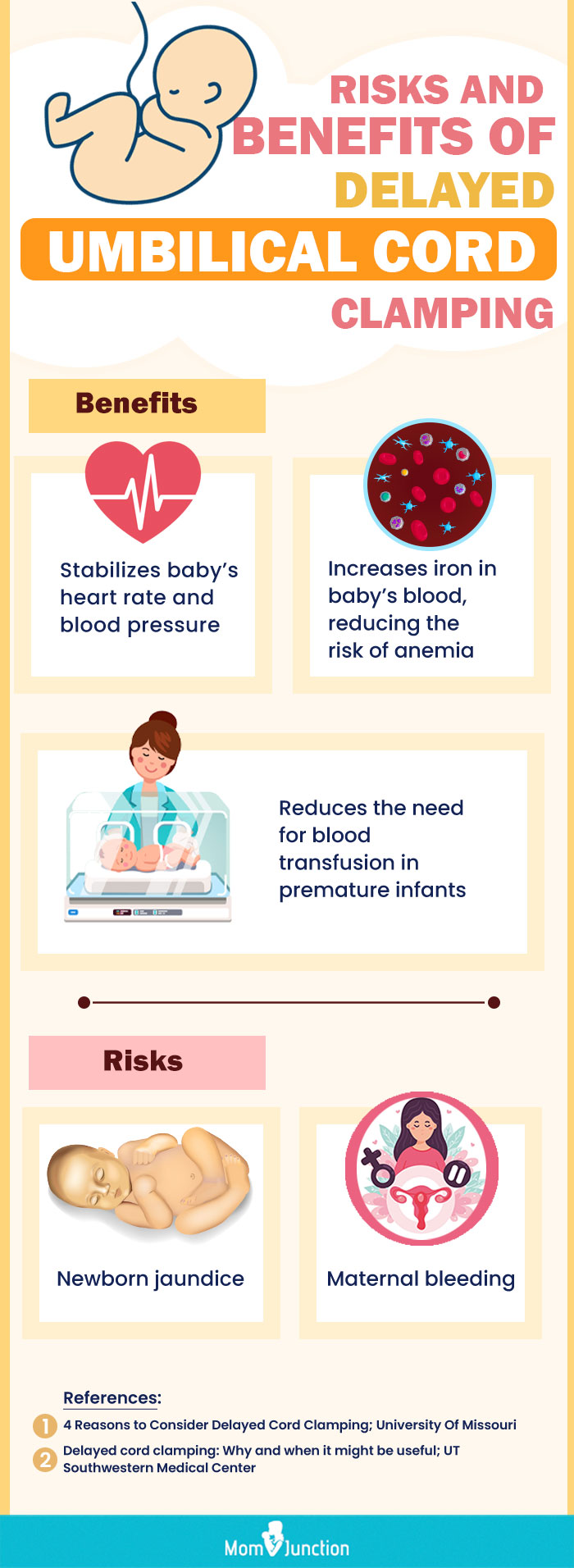
Key Pointers
- The umbilical cord provides oxygen and nutrients to the fetus and aids in waste removal.
- Antibodies carried by the umbilical cord protect the baby from infections in the first months after birth.
- Stem cells present in the umbilical cord can rebuild the immune system and bone marrow.
- Maintaining cleanliness and dryness of the umbilical cord stump promotes healing and prevents infection.
- The umbilical cord stump typically falls off within 5-15 days, but if it takes over four weeks, medical attention is necessary.
Watch a concise instructional video on caring for your newborn’s umbilical cord to learn step-by-step techniques and best practices.
References
- Blood Circulation in the Fetus and Newborn.
https://www.chop.edu/conditions-diseases/blood-circulation-fetus-and-newborn - Umbilical Cord Care.
https://www.urmc.rochester.edu/encyclopedia/content.aspx?contenttypeid=90&contentid=P02646 - Umbilical cord care in newborns.
https://medlineplus.gov/ency/article/001926.htm - Neonatal omphalitis: a review of its serious complications.
https://pubmed.ncbi.nlm.nih.gov/16825129/ - Umbilical hernia repair.
https://medlineplus.gov/ency/article/002935.htm - H Nagar; (2001); Umbilical granuloma: a new approach to an old problem.
https://pubmed.ncbi.nlm.nih.gov/11666047/ - Cord Blood Myths and Facts.
https://www.cb-association.org/myths-and-facts - Umbilical cord care.
https://www.pregnancybirthbaby.org.au/umbilical-care - Caring for your baby’s umbilical cord stump and belly button.
https://www.childrens.health.qld.gov.au/fact-sheet-caring-for-your-babys-umbilical-cord-stump-and-belly-button/ - Umbilical cord conditions.
https://www.marchofdimes.org/find-support/topics/birth/umbilical-cord-conditions - Use of umbilical cord blood for stem cell research
https://pubmed.ncbi.nlm.nih.gov/20370983/ - Urologic anomalies and two-vessel umbilical cords: what are the implications?
https://pubmed.ncbi.nlm.nih.gov/12648433 - Pediatric Umbilical Hernia.
https://www.ncbi.nlm.nih.gov/books/NBK459294/





